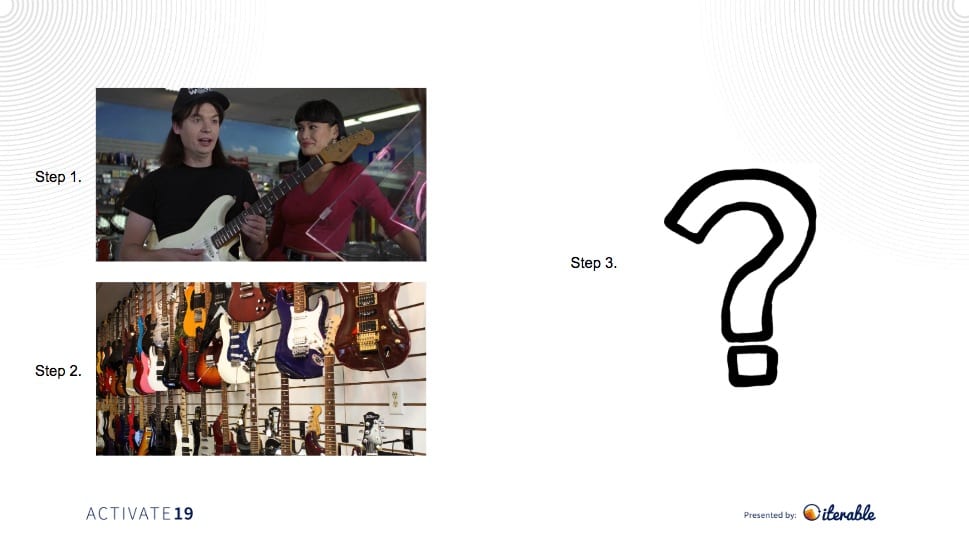As we’re gearing up for Activate London in the fall, we’ve been thinking a lot about the impactful sessions shared at this spring’s conference in San Francisco. Brands everywhere are investing in improving their customer experiences, but few share a behind-the-scenes look at how they’re actually doing it—which is why we’re diving into a brilliant presentation by Fender.
Brian Schmidt, Director of CRM & Retention at Fender, showcased an effective approach for defining your brand’s most important differentiators to truly win over long-term customers for life. We’ve put together a high-level overview below, but we highly recommend checking out the full session for a deep dive.
Tuning Into the Sounds of the Market
Every consumer-facing brand out there needs to stay on their toes when it comes to offering a best-in-class experience. With competition abound, marketers must rabidly benchmark themselves against the “industry standard” to find out where they stand, and where they can get a leg up. But how exactly do you do that?
To amp up their customer journey, Fender gathered their team to get a lay of the land and start distilling down the reasons why guitar enthusiasts were choosing Fender over the rest. As you start to take note of what’s happening in your industry, here are three core questions Fender asked to find the key pieces of information they needed to start their market analysis:
1. Are you one product of many serving the same function?
Over the past 70 years, Fender has produced some of the most iconic guitars and amps in history, but such equipment won’t offer players much if they don’t know how to play. Fender found their key customer opportunity by expanding their education and learning initiatives.
2. Are you a service that facilitates a broader journey?
Fender is synonymous with music culture and players of all skill levels, which results in a lot of variance as to why players choose them for guitars. This recognition helped them identify the need for designing multiple customer paths for a more personalized experience.
3. Is your product a high-frequency purchase? Or a low frequency, but high use purchase?
Players might not buy a guitar every month, but they turn to Fender for more than just the instrument. Related gear like strings, amps, and other accessories are all available for purchase and will experience moments of high relevance during the customer journey. Fender explored how they could enrich their experiences with complementary promotion and cross-sell strategies.
Once they understood their role in their market, the Fender marketing team built cross-channel programs to help build the customer experience around specific important milestones.
Personalizing the Player’s Path Along the Journey
With a deeper understanding of their fit inside the general marketplace, Fender recognized the need for their marketing to effectively facilitate the different paths of their customers journeys. Why? Their research showed that 90% of first-time guitar players will quit within 6 months.
Survey data pointed them to design their marketing experience around three core customer questions about learning the guitar:
- Why do they want to play? (interested in developing a new skill; motivated by a specific event; inspired by an artist, a friend or relative)
- Where can they get a guitar? (purchased, rented, gifted or inherited, borrowed from someone)
- What comes next? (guitar books, YouTube tutorials, online courses, private lessons)


Fender’s research showed that a significant portion of new players’ journeys end shortly after guitar acquisition.
Personalizing an individualized experience differentiated Fender inside the musical instrument market. They deduced that if they could support the customer journey before the typical experience cliffs, then they would be well-equipped to nurture long-term loyalty.
Find the Customer’s Rhythm
By conducting this journey-mapping exercise and looking into the richly nuanced layers of customer experiences, Fender discovered new ways to support the players’ “purpose” (from learning through mastery) and ultimately positioned their brand as not only a leading guitar manufacturer but also a trusted partner.
Fender also found a trusted partner in Iterable to translate their customer journey into sophisticated cross-channel campaigns, with workflows specifically designed to increase engagement and retention.
“Iterable allows us to drive the customer journey in a completely different way than we were able to before,” said Schmidt. “Centralizing in-app messaging, push messaging, and email on one platform, with a unified customer profile view, enables us to seamlessly engage across our digital and physical universe. With all our data in one place, we can strategically drive lifetime value.”
This highlighted recap only scratches the surface of their presentation—watch their full Activate video to learn how they tailored their findings through every stage of their acquisition funnel.






























